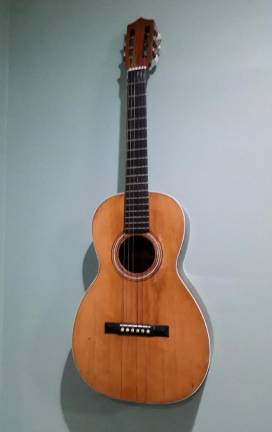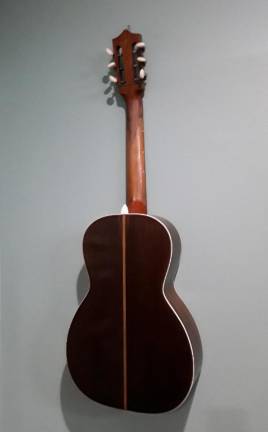History of a Fine Guitar


She came to life in the workshop of C. F. Martin & Co in the year 1886. The shop was at 196 Hudson Street in lower Manhattan. Opened in 1833 it was only blocks away from the mouth of the newly constructed Holland Tunnel.
Proof of her age is interesting. It was during those years that Martin thought New York was too dirty and crowded and moved his factory to the serene countryside of Nazareth, Pa., completing that move in 1898. Guitars made between 1865 and 1898 were stamped “C.F. Martin & Co., New York” and that stamp appears several times within her body. Martin did not begin giving his instruments serial numbers until 1898 but there is a penciled inscription inside her sound box that reads “CK 1886.” It is thought that during those years Martin made upwards of two hundred instruments a year. I wonder how many are still singing their song today.
Imagine: in 1886, Grover Cleveland was President of the United States. Transportation was by horse and wagon and the availability of electricity was still a long way off. A loaf of bread sold for six cents and coffee was twenty-two cents a pound.
And for the next sixty-five years her whereabouts remain unknown. Where was she? Did she travel the world? Who coaxed her into beautiful sound? What kind of music came forth?
Only she knows what transpired during those years until 1951 when my Uncle Calmen, an accomplished violinist and viola player for the New York Philharmonic, found her in the shop of the luthier Noah Wolfe. The shop was upstairs on 48th Street in New York. Given that the block was home to many stores and shops catering to mostly professional musicians, it was at the time referred to as “Music Row.”
And she was then what she is now - a Martin Model 1-26, made by a now unknown craftsman identified only as “CK” in the year 1886.
Her top is of Adirondack Spruce and her “V” shaped neck of cedar.
Her back and sides of Brazilian Rosewood - luxurious still and hardly looking their one hundred and thirty four years. Brazilian Rosewood, long thought to be the finest tonewood for guitars, is on the endangered list and currently remains difficult to obtain.
Ivory bindings frame the woods of her front and back and her finger board of ebony remains deep and dark and unscathed to this day. Her original bridge with a triangulation on each side, is also of ebony, and the bridge pins are the original ivory and mother of pearl.
She has been with me all this time, almost seventy years since I first eked out some basic tunes not then realizing what a treasure I held in my hands. She had then - and continues to have - her own unique voice: deep, resonant, pure and mellow.
She has seen the decades of my life. She has seen me move from boy to man ... to husband, father and grandfather. And all through the years providing me with a source of comfort as I would coax her beautiful voice into song. And as I age that comfort seems to be even more soothing, her mellow tones so welcome to this old man’s ears.
Unlike we mortals her future seems more or less secure. If treated with appropriate care, there’s no reason why she shouldn’t continue to sing her beautiful song. And to that end, when I become unable to do so, I have entrusted her ongoing care to my grandson. A young man who has shown a love and an affinity for the pleasure that music can bring into one’s life.
So I will pick her up once again and relish the time as we both fall into the ease of a familiar tune.
Harmon Rangell, has been married to the same good woman for 57 years. He is a father, grandfather, retired businessman, writer, part time musician, collector of Bonsai trees, and self-described “Pool Room Junkie”. His novel “Jake’s Tale” is available at Amazon.com.